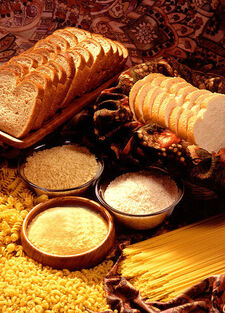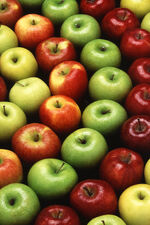
Grain products are rich sources of carbohydrates
Carbohydrate counting is a useful method to control one's intake of foods, and is especially relevant for persons with Diabetes. It is an important tool of Diabetes management, and its approach to meal planning is flexible. Carbohydrate counting revolves round the foods containing larger amount of carbohydrates, and aims at planning meals in such a way that blood sugar remains within normal ranges.
There are certain foods which have high carbohydrate contents compared to other food. Example of foods rich in carbohydrates are: foods made of grains like breads, pasta, cereals; vegetables & fruits, particularly root crops like potatoes, sweet potatoes, and yams; all alcoholic beverages like beer and wine; desserts and candies; most of the milk products except cheese. Some foods may be nutrient-dense carb foods while some may be low-nutrient carb foods. Foods prepared from whole grains, legumes, milk products (except cheese), fruits and vegetables are example of nutrient-dense carb foods. Low-nutrient foods include table sugar, candies, and beverages containing alcohol.
Carbohydrate Metabolism
Once the digestion process starts by break down carbohydrates into glucose and release it into the blood streams. The available blood-glucose is either use for energy or stored as glycogen in the liver and muscles, or there is no energy requirement then glucose is converted and stored in the body as fats.
All the above-said glucose metabolism requires insulin; people with diabetes cannot produce enough insulin or not sensitive to insulin, and thus they need to maintain their blood-glucose level with medications or insulin or lifestyle changes.
Introduction[]
Carbohydrate in the food that we eat has a large impact on the level of our blood sugar. Diet containing complex carbohydrates (sometimes simply called complex carbs) result into good and healthy nutrition. Examples of complex carbs are vegetables, fruits, root crops, and whole grains. On the other hand, diet with high fat contents results into over weight and even obesity, insulin resistance, higher blood sugar and these conditions result into many health complications. Consumption of carbohydrates should be balanced with insulin (naturally produced or taken by way of injection) or exercise (preferably both with insulin and exercise) to keep the level of blood sugar within normal range. Herein lies the significance and importance of carbohydrate counting, particularly with persons with diabetes. It involves five basic steps[1]:
- Making healthy food choices
- Focusing on carbohydrates
- Setting carbohydrate goals
- Determining carbohydrate contents
- Monitoring the level of blood sugar
Counting carbs[]

Different apples - different carbs
Some foods like table sugar or glucose tablets are fully carbohydrates and so their weight will indicate the carbohydrate content - 100 grams of sugar will be almost 100 grams of carbohydrates. Counting carbohydrates in some other item of foods may involve a a bit of calculation. An example of carbohydrate counting may be illustrated with counting carbohydrates of apples of different sizes and weight. For instance, on a gram scale, the average weight of a Rome is 238 grams and a Gala apple weighs around 139 grams. An apple has around 13% of carbohydrates by weight. Thus, carbohydrate content in a Rome apple will be around 30.9 grams of carbohydrate (238 x 0.13 = 30.9 gram) while the carbohydrate in a gala apple will be around 18.1 grams (139 x 0.13 = 18.1 grams). In this way, total carbohydrate count of all the foods consumed in a day should be calculated, and the insulin intake should be adjusted in consultation with health care professionals.
The above example was by way of a general illustration. A little more is required to count carbohydrates in different foods. Exact or almost exact carbohydrate counting requires common equipments like a small weighing machine, and cups and spoons for measuring. One may count carbohydrate by one or more of the following methods:
- By reading labels on the packed foods
- By reference to books and cookbooks
- By measuring using scales, cups and spoons
Ways to take carbohydrates[]
- Choose appropriate size of carbohydate not too large.
- Break down carbohydrate size (quantity) and spread evenly throughout the day.
- Take low in fat diet, particular emphasis is on saturated fat.
- Prefer high-fiber carbohydrate foods such as whole-grain breads and cereals, dried beans, lentils, starchy vegetables and fruits.
See also[]
External links[]
- Carbohydrate Counting
- Carbohydrate counting tables
- Carb Counting - a page from the ADA
- All About Carbohydrate Counting
- Diabetes & Carbohydrate Counting
- Diabetes Carbohydrate Counting